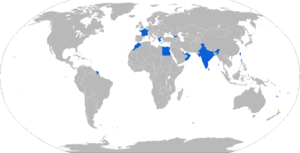MICA (missile)
| MICA | |
|---|---|
|
An air-launched MICA on a Dassault Rafale | |
| Type | Short/medium range air-to-air and surface-to-air missile |
| Place of origin | France |
| Service history | |
| In service | 1996 |
| Used by | See Operators |
| Production history | |
| Manufacturer | MBDA |
| Specifications | |
| Weight | 112 kg[1] |
| Length | 3.1 m[1] |
| Diameter | 160 mm[1] |
| Warhead | 12 kg warhead[1] |
Detonation mechanism | Proximity or direct impact[1] |
|
| |
| Engine | Solid-propellant rocket motor |
Operational range | |
| Flight altitude |
|
| Speed | |
Guidance system |
|
Launch platform |
|
The MBDA MICA (Missile d’interception, de combat et d’autodéfense, “interception, combat and self-defence missile”) is an anti-air multi-target, all weather, fire-and-forget short and medium-range missile system. It is intended for use both by air platforms as individual missiles as well as ground units and ships, which can be equipped with the rapid fire MICA Vertical Launch System. It is fitted with a thrust vector control (TVC) system. It was developed from 1982 onward by Matra. The first trials occurred in 1991, and the missile was commissioned in 1996 to equip the Rafale and Mirage 2000. It is a replacement for both the Super 530, in the interception role, and the Magic II, in the dogfighting role.
On 11 June 2007, a MICA launched from a Rafale successfully demonstrated its over-the-shoulder capability by destroying a target behind the launch aircraft. The target was designated by another aircraft and coordinates were transmitted by Link 16.[4]
Characteristics
There are two MICA variants; MICA RF has an active radar homing seeker and MICA IR has an imaging infra-red homing seeker. Both seekers are designed to filter out counter-measures such as chaff and decoy flares. A thrust vector control unit fitted to the rocket motor increases the missile’s agility. The missile is capable of lock-on after launch (LOAL) which means it is capable of engaging targets outside its seeker’s at-launch acquisition range. Mounted on the Rafale, the MICA IR can provide IR imagery to the central data processing system, thus acting as an extra sensor.[5]
MICA can also be employed as a short-range surface-to-air missile. It is available in a ground-based version, VL MICA, fired from a truck-mounted box launcher, and a naval version, VL MICA-M, fired from a ship-fitted vertical launch system.[3] On October 23, 2008, 15:30, at CELM, Biscarosse (Landes), a VL MICA missile successfully performed the last of its 14 test firings meaning it is now ready for mass production. The target drone was flying at low level, over the sea, 12 km away; despite this distance, MICA, equipped with an active radar seeker, locked on the target and shot it down.
Corvettes too small to have the big and costly Aster missile system are the most likely customers for the VL MICA-M, which offers similar capability as the Aster 15 but without its booster and PIF-PAF vectorial control.[6]
While the VL MICA has an advertised range of 20 km, aerodynamic performance is significantly degraded at those ranges. From 0 to 7 km MICA has maneuverability of 50g, however by 12 km this is reduced to 30g as energy is lost.[7]
Variants
- MICA RF
- MICA EM
- MICA IR
- VL MICA RF
- VL MICA IR
- VL MICA-M RF
- VL MICA-M IR
Operators

Current operators
- French Air Force: used on Mirage 2000-5 and Rafale aircraft.
- French Navy: used on Rafale M aircraft.
- Georgian Air Force: VL MICA[8][9] along with GroundMaster 200 and 400 radars from ThalesRaytheonSystems.[10]
-
 India
India
- Egyptian Air Force: MICA IR
- Egyptian Navy: VL MICA installed on Gowind-class corvette
- Royal Navy of Oman: used on the Khareef-class corvettes.
- Republic of Singapore Navy: Independence-class littoral mission vessel is equipped with the VL MICA[13]
Future operators
- Royal Malaysian Navy: VL MICA has been selected to be installed on six Second Generation Patrol Vessels
- Indonesian Navy: VL MICA to be installed on two new Sigma 10514 frigates
See also
References
- 1 2 3 4 5 6 7 VLS MICA, MBDA, retrieved 24 November 2014.
- 1 2 "MICA", Global Security, retrieved 24 November 2014.
- 1 2 Mica Vertical Launch Short-Range Air-Defence System, France, Army technology, retrieved 24 November 2014.
- ↑ "Tir MICA depuis un Rafale F2: quand le chasseur devient la cible" [MICA shoot from a Rafale F2: when the hunter becomes the target] (in French). Armées.
- ↑ de Briganti, Giovanni (2011-05-31). "Rafale in Combat: "War for Dummies"". Defense aerospace. Retrieved 2011-06-25.
- ↑ "news section", A&D dic, 2008.
- ↑ VL MICA (PDF), MBDA, retrieved 24 November 2014.
- ↑ "Armement : la France fait une belle percée en Géorgie", La Tribune.
- ↑ "Georgia buying air defense systems without disclosing details of arms deals", Eurasia Daily.
- ↑ "Paris Air Show 2015: Georgia signs major air-defence contract with Thales", Jane's.
- ↑ "Cabinet Committee clears 950 million Euro deal to procure 500 air-to-air missiles for Mirage 2000". The Economic Times. The Times of India. 2012-01-04.
- ↑ Hunter, Jamie (20 June 2007), "Upgraded Moroccan Mirage marks first signing for Astrac partnership", FlightGlobal.
- ↑ "Singapore selects VL Mica for new littoral mission vessels", Jane’s.
External links
| Wikimedia Commons has media related to MBDA MICA. |
- "MBDA's Anti-Ship & Air Defence Weapons at LIMA 2013: Multiple Solutions For Multiple Missions", Navy recognition.